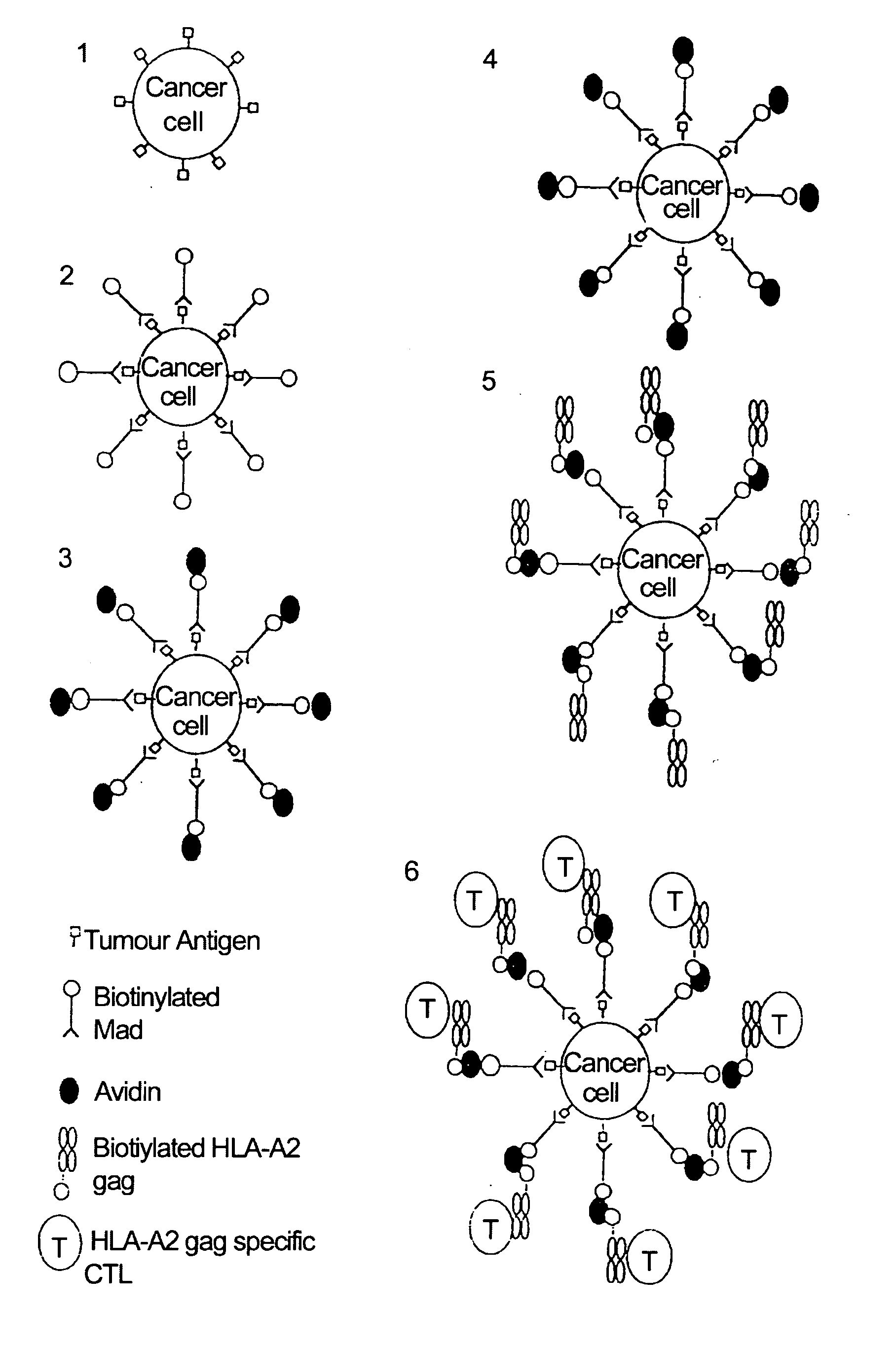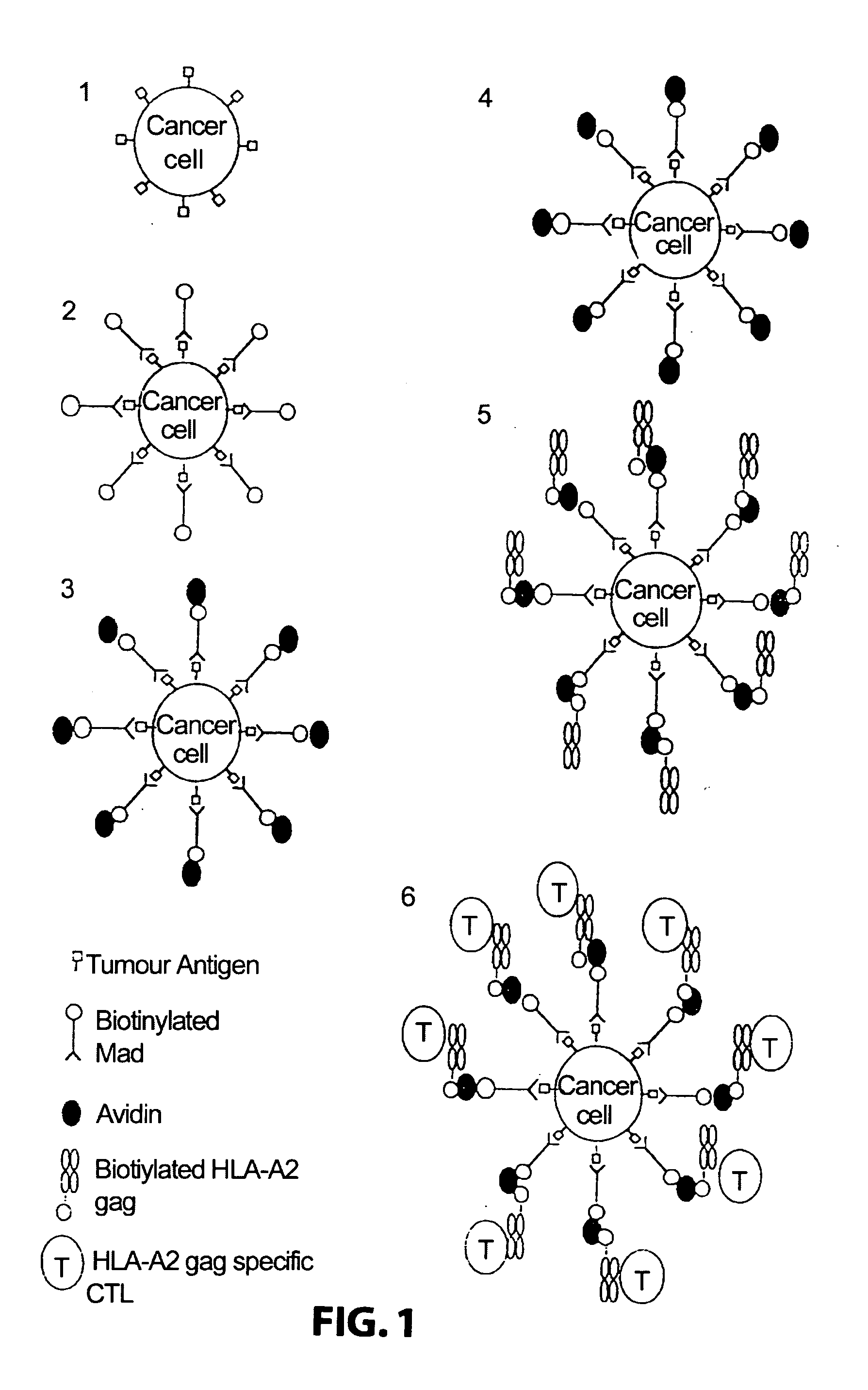Method for producing cytotoxic T-cells
a cytotoxic and t-cell technology, applied in the field of cytotoxic t-cell production, can solve the problems of low efficacy, complex and low efficiency, and the number of hla molecules presenting such peptides is generally too small to stimulate an effective immunological response against tumour cells
- Summary
- Abstract
- Description
- Claims
- Application Information
AI Technical Summary
Benefits of technology
Problems solved by technology
Method used
Image
Examples
example 1
[0120] The following components were used:
[0121] Target cells: A human melanoma cell line Mel 1, deposited at the Department of Immunology, Institute of Molecular Medicine, Oxford, that carries the HLA class I allotype HLA-A2. The cell line was grown in standard RPMI tissue culture media. A human melanoma cell line Mel 2, deposited at the Department of Immunology, Institute of Molecular Medicine, Oxford, that does not carry the HLA class I allotype HLA-A2. The cell line was grown in standard RPMI tissue culture media.
[0122] Attaching means: A monoclonal antibody 225.28s (Buraggi 1985 Cancer Res. 45 3378-3387) that binds to the HMW-MAA antigen on human melanoma cells. Biotin is chemically conjugated onto this antibody as described in Bayer 1990, Methods Embryology 184, 138-160.
[0123] Pure hen egg avidin obtained commercially from Societa Prodotti Antibiotics, Milan, Italy.
[0124] HLA: Biotin conjugated recombinant HLA class I allotype HLA-A2 molecules, as described in Altman 1996, Sci...
example 2
[0133] The following components were used:
[0134] Target cells: The Daudi B cell line (MHC class I-negative), melanoma line SK-mel29 (HLA-A2.1-positive), 0.221 / A2 (HLA-A2.1-positive), were maintained in RPMI media with 10% fetal calf serum and antibiotics in a 37.degree. C. incubator with 5% CO.sub.2.
[0135] Attaching means: Monoclonal antibodies 225.28s (Buraggi 1985 Cancer Res. 45 3378-3387) and 2147 that bind to the I-IMW-MAA antigen. Biotin is chemically conjugated onto these antibodies as described in Bayer 1990, Methods Embryology 184, 138-160.
[0136] Pure hen egg avidin obtained commercially from Societa Prodotti Antibiotici, Milan, Italy.
[0137] HLA : Biotinylated complexes of recombinant MHC class I and peptide were produced as described previously. (Altman et al, Science 274, 1996, 94-96; Ogg et al, Science 279, 1998, 2103). Prokaryotic expression of B2M and MHC class I heavy chain, modified by the C terminal addition of a target sequence for the biotin ligase enzyme BirA, was...
example 3
[0150] Immunization / vaccination of a subject using HLA class I / peptide complex(es) to produce and / or amplify immune response(s) directed at particular cell surface molecule(s) may be accomplished according to the present invention. The immune response(s) thus produced are preferably directed at tumour cells which comprise the particular cell surface molecule(s) to which the immune response is produced. The form of this response is influenced by the particular HLA class I / peptide complex(es) used in the immunisation procedure(s).
[0151] In this example, use of antibody targeted HLA class I / peptide complexes to amplify a specific CTL response is demonstrated. Thus, example 3 also encompasses a method for delivering HLA class I / peptide complexes to the surface of antigen presenting cells.
[0152] In brief, it is demonstrated that biotinylated HLA-A2 / peptide complexes immobilised on the surface of an antigen presenting cell via an antibody bridge cause the activation, amplification and exp...
PUM
| Property | Measurement | Unit |
|---|---|---|
| time | aaaaa | aaaaa |
| time | aaaaa | aaaaa |
| concentration | aaaaa | aaaaa |
Abstract
Description
Claims
Application Information
 Login to View More
Login to View More - R&D
- Intellectual Property
- Life Sciences
- Materials
- Tech Scout
- Unparalleled Data Quality
- Higher Quality Content
- 60% Fewer Hallucinations
Browse by: Latest US Patents, China's latest patents, Technical Efficacy Thesaurus, Application Domain, Technology Topic, Popular Technical Reports.
© 2025 PatSnap. All rights reserved.Legal|Privacy policy|Modern Slavery Act Transparency Statement|Sitemap|About US| Contact US: help@patsnap.com



